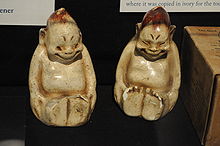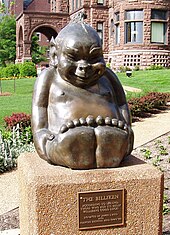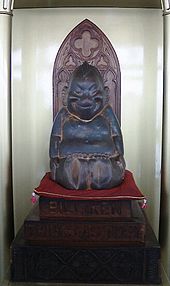Billiken
The Billiken is a lucky charm in the form of a doll or statue, which was invented in the USA, but has clear echoes of East Asian gods of luck. The Billiken is usually depicted as a grotesque human figure who sits with his feet stretched forward, shows a mischievous smile, and has pointed ears.
role models
Models of the Billiken are various East Asian deities, such as the Chinese god of happiness Fuk , the Chinese Buddha Mi-lo fo or the Japanese Bodhidharma .
origin
The American art teacher and illustrator Florence Pretz patented the figure of Billiken on October 8, 1908, which allegedly appeared to her in a dream. Pretz probably designed the Billiken after the Chinese Joss or another Asian god figure. Possibly she adopted the name for the character from the poem Mr. Moon. A Song of the Little People by Bliss Carman and Richard Hovey , but maybe the name was not chosen by Pretz at all, but by one of the later manufacturers of the figure. From 1909 the dolls, which supposedly brought their buyers luck, were sold; In the first six months of production, 200,000 units were sold in the USA and Canada. The Billiken was initially produced by the Horsman Company.
The first Billiken song was also published in 1909. It was called The Billiken Man . The text was by E. Ray Goetz , the music by Melville J. Gideon . A recording of this song with Blanche Ring was distributed by the Billiken Co. of Chicago. Another song was called Uncle Josh and the Billiken .
As early as 1909, the Billiken became the mascot of the Alaska-Yukon-Pacific exhibition held in Seattle .
Billiken as a sports mascot
The Billiken became the official mascot of athletes at Saint Louis University and Saint Louis University High School around 1910 or 1911 . There is a Billiken statue in front of the Chaifetz-Arena on the university campus, and another on the high school one. There are various reports about the development of the connection between Pretz's fictional character and the sports teams; usually, however, a connection is made between trainer John Bender and the grinning Billiken. Bender was also caricatured as Billiken and his athletes were referred to as "Bender's Billikens".
Billiken as an aviator mascot
In Germany the Billiken was used as an amulet by the pilots around Jacob Goedecker on the Großer Sand near Gonsenheim . Carl Zuckmayer reported: “The pilots wore leather suits, crash helmets and a small, strange amulet in their pockets, not Saint Antonius, but the god Billiken - presumably introduced by Fokker -, a fat black idol, without which starting was considered a certain doom . “From the First World War , a photo of a single-seat combat school in Warsaw is known that shows a billiken on the hull of a Fokker DV. The Billiken was supposed to protect the student pilot or his plane.
Corruptions and imitations
Double figures with the inscriptions “Billy can” and “Billy can't”, one with a happy, relaxed smile, the other with an unhappy facial expression, show figures resembling Billiken, but they are often not flat on the floor, but apparently on the toilet sit. Gobbo was especially recommended to motorists to protect them from breakdowns, and Silligan was marketed as the deity of laughter. Rose O'Neil created other dolls based on Billiken, which she patented in 1909, including the Buddha Ho-Ho . The same year that Pretz patented the Billiken, the Florentine Alabaster Co. in Chicago patented a Joss figure that is sometimes viewed as a model for the Billikens. However, Ray believes the reverse is likely. During World War II , female Billikens were also sold under the name Milliken and Billikens with a fold-up penis.
In 1910 a philatelic magazine called Billikin came out. While the final syllable was deliberately changed here - the publisher's last name was Kin - there were later numerous unintentional misspellings of the name Billiken. For example, TC Lewellen published a short story called The Billikin Courier in 1958 .
In 1911 Honolulu founded The Royal Order of Jesters , which made billiken its symbolic figure. After the origin of this symbolic figure had been forgotten for years, the Jesters became aware of Dorothy Jean Ray's research and finally had their Billiken re-patented. The figure is usually depicted with green glass eyes and a red glass navel.
From 1920 to 1946 the illustrated magazine Billiken was published in Caracas . In 1929 the Billiken Club for Chicago Children was founded and Bud Billiken became the patron of black children. Since then, a parade and a picnic have been held every year.
In Fairbanks , there is a lounge Billiken , in Seattle a Billiken Ski Club and Anchorage a theater after the Billiken is named. A children's shoe brand also bears the name Billiken. Bizarrely, a Billiken was also featured as the top figure on a totem pole that graced a 1966 Bureau of Indian Affairs brochure , and several Billikens have also been featured in books on the Siberian Chukchi . Presumably these figures were introduced from Alaska to Siberia soon after 1909. The Chukchi writer Juri Rytcheu , who came from Chukotka , took up the motif of the Billikens in his story The Sea Lion .
Aftermath in Japan
Despite the large numbers, not too many Billikens have survived from the early days of production. The Japanese toy collector Teruhisa Kitahara sparked a Billiken boom in Japan with a TV report about Billikens. Billiken statues can be found in Osaka and Tokyo ; a relief of a Billikens is in the amusement park Namja Town in Tokyo. A Billiken film called Biriken was made in Japan in 1996 by Sakamoto with Norimichi Kasamatsu .
Ray's research
The anthropologist and historian Dorothy Jean Ray first published an essay on billik in the Alaska Sportsman in September 1960 . A more detailed Ray treatise on the same subject appeared in the 1974 Alaska Journal . She also reported on Billiken in A Legacy of Arctic Art .
Ray first came across the Billiken figures in 1945, in the form of ivory carvings that were sold in bulk in Nome . At that time she was told that these figures had always been made by the Eskimos . Ten years later, she learned that the ivory carver Angokwazhuk had carved a billiken in Nome for the first time in 1909 - at the suggestion of a dealer. Angokwazhuk was then copying a character imported from the United States. Using the patent number on an old Billiken, which she discovered in an antique shop in Seattle, Ray was able to establish the connection to Florence Pretz and now finally prove that the Billikens were by no means original Eskimo art. Ray examined Pretz's children's book illustrations and found a resemblance to the brownies invented by Palmer Cox in 1887 .
According to Ray, not one of the ideas originally widespread with the Billiken figure is the idea that the figure brings luck when you buy it, but even more when it is given away and most of all when it is stolen. This notion probably only emerged in the nome of the 1940s or 1950s. In the early days, the Billiken was often sold in combination with little poems about its good luck, or on a leaflet it was stated that the lucky charm was only loaned to the owner for 100 years and 100 cents.
Others
Billiken is a youth magazine in Argentina whose name goes back to the Billiken lucky charms.
Web links
- Detailed page about Billiken with numerous photos
- Dorothy Jean Rays essay from 1974
- Billiken on fuselage of airplane 1917
Individual evidence
- ↑ Chinese god triads Fuk, Luk and Sau (Eng. Fu, Lu, Shou) en: Fu Lu Shou
- ↑ a b Website on the tradition of the University of Saint Louis Billikens ( Memento of January 3, 2011 in the Internet Archive ); according to Dorothy Jean Ray, the patent dates back to October 6th.
- ↑ According to Ray, a complete Billiken doll with an unbreakable head received the first known patent on an entire doll shape on July 22, 1909.
- ↑ a b c http://www.churchofgoodluck.com/Billiken_Lore.html
- ↑ Carl Zuckmayer, As if it were a piece of me. Listening to friendship , S. Fischer Verlag 1986, ISBN 3-10-096534-5 , p. 172
- ↑ http://www.buddecke.de/kswarschau.htm
- ^ Dorothy Jean Ray, A Legacy of Arctic Art , University of Alaska Museum, University of Washington Press, Seattle, 1996, pp. 15, 132, 164-169, 177




